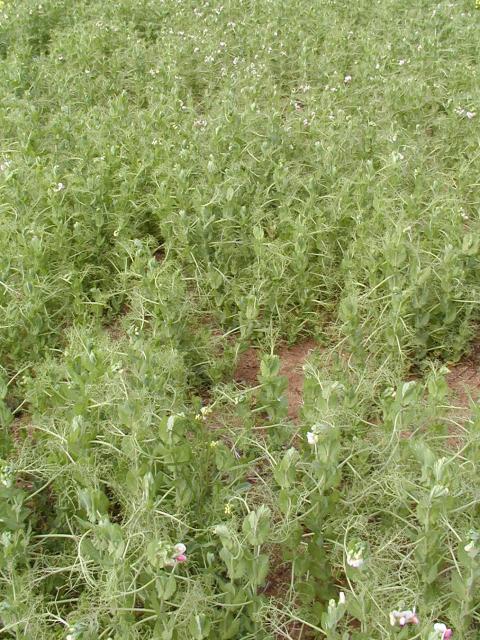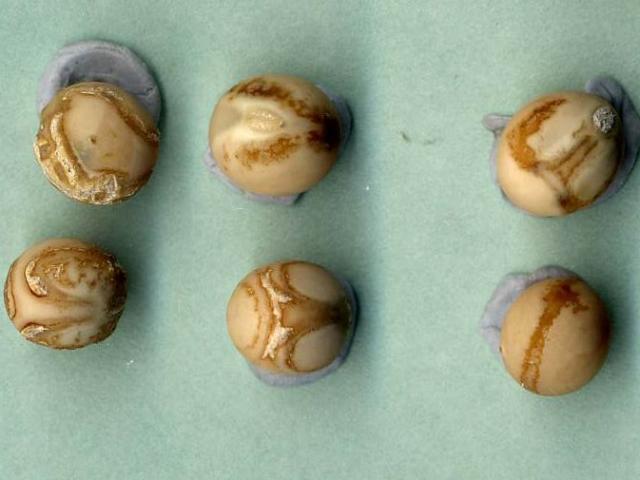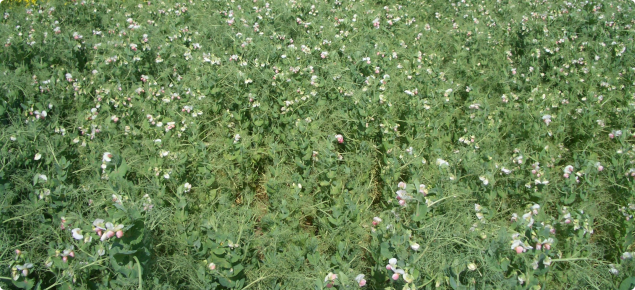Symptoms
Plants
Seed-borne PSbMV infection in field pea causes pale, stunted plants. When young field pea plants are infected with PSbMV by aphids, leaf symptoms include faint mottle and downward rolling and affected plants show mild stunting. These symptoms are difficult to see and normally all that can be observed are depressions within the crop canopy (Figure 1), which contrast with the flat, even canopy of crops sown with healthy seed (Figure 2). This uneven canopy is an important indicator of widespread crop infection with PSbMV.

Seed
Severe defects in seed appearance result when pea plants are infected with PSbMV before or during seed development. Typical defects include necrotic rings and line patterns on the seed coat (sometimes referred to as 'tennis ball' symptoms), malformation, splitting and reduced seed size (Figure 3). Such symptoms are most obvious in white-seeded pea varieties. The proportion of seeds giving rise to infected seedlings is usually much smaller than the proportion of seeds with symptoms.

Sources of virus
PSbMV survives between growing seasons in infected stocks of field pea seed. Seed-borne infection is the main way the disease spreads from paddock to paddock and from farm to farm. Sowing infected seed produces infected plants scattered at random within the crop. Aphids then pick up the virus from these infected plants and spread it to healthy plants. The seed transmission rate to seedlings varies with field pea variety. For example, seed transmission rates for Kaspa can be up to 25%, while for Twilight, rates are less than 5%.
Although infected field pea seed is the main source of PSbMV, occasionally infected faba bean, chickpea, lentil, grass pea and vetch crops are potential virus sources. However, lupins and pasture legumes such as clovers and medics do not become infected.
Aphid vectors
PSbMV is spread by many aphid species including the green peach (Myzus persicae), cowpea (Aphis craccivora) and pea (Acyrthosiphon pisum) aphids. PSbMV is transmitted non-persistently. This means an aphid picks up the virus within 1-2 seconds while probing an infected plant and then transmits the virus within 1-2 seconds to healthy plants. However after the aphid has probed 1-2 healthy plants it loses the virus from its system and will not transmit it again until it picks up another virus from an infected plant.
Yield losses
The yield impact of sowing seed infected with PSbMV varies greatly from year to year and site to site. Yield losses can be substantial in ‘green bridge’ years when aphid populations build up early but are minimal when there is a dry start to the season. PSbMV infection in field pea crops is most widespread and serious when seed with more than one per cent infection is sown and aphids arrive early in the life of the crop resulting in widespread plant infection before or during flowering. Plants infected early become stunted and produce fewer seed pods, resulting in a high potential for yield loss.
In field experiments, yields of the variety Kaspa were reduced by up to 25% when 6.5% PSbMV-infected seed was sown at two wheatbelt sites in a year with early aphid arrival. Seed transmission levels in harvested seed were 10%. By contrast, sowing seed with less than one per cent infection during a year with late aphid arrivals had no measurable effect on yield and there was no detectable seed transmission level in harvested seed (Table 1).
| Scenarios | 1 | 2 | 3 | 4 |
|---|---|---|---|---|
| Seed infection | >5% | >5% | <1% | <1% |
| Aphid arrival | early | late | early | late |
| Crop infection at full pod set | 100% | 40% | 40% | 15% |
| Yield loss | 25% | 10-15% | 10-15% | no effect |
| Seed transmission | 10-20% | 1-3% | 1-3% | 0% |
Management
PSbMV is difficult to manage in high-risk areas where infected seed is sown and early seasonal rainfall enables the build up of a substantial green-bridge and therefore early aphid arrival.
To minimise PSbMV spread in field pea crops it is necessary to implement an integrated disease management approach:
- Sow healthy seed. Sow seed from a virus-tested seed stock. Before sowing seed a representative 400-seed sample should be tested for PSbMV infection. In high rainfall zones with long growing seasons only sow seed with less than 0.5% infection. In medium-low rainfall zones in years with a substantial ‘green bridge’ sow seed with less than 1% infection. In medium-low rainfall zones in years with a minimal ‘green bridge’ seed with less than 2% infection should be sown.
- Target early canopy development. Early seeding at high rates (more than 120kg/ha) and narrow row spacing (18cm) will promote an early, dense plant canopy before aphid arrival. This will help shade out the seed-infected plants that act as a source of PSbMV infection and also reduce aphid landings. Aim for a plant density of at least 55plants/m2.
- Retain stubble. A stubble groundcover helps decrease early virus spread by reducing aphid landing rates while bare earth between plants attracts incoming migrant aphids.
- Avoid potential virus sources. Avoid spread of infection by isolating pea crops from other pulse or field pea crops sown with untested seed stocks as these could be a potential source of PSbMV.
- Resistant varieties. Currently there are few resistant varieties available. Varieties Wharton and Yarrum are resistant to PSbMV infection but Yarrum has generated variable yields in Western Australia so might not be well suited.
- Avoid sowing high-quality seed crops in high risk, aphid prone regions.
Note: Spraying insecticides is unlikely to be of any benefit because insecticides do not act fast enough to prevent the rapid spread of the virus by aphids and may increase rather than reduce virus spread because aphids move around more on sprayed plants.
Management decision support –free SMS service
A forecasting model informing a management decision support system has been developed for PSbMV in field pea. Each season, growers can be reminded to get seed tested, assess their PSbMV risk and make informed management decisions using the free SMS PSbMV risk alert service. This risk alert service will complement the existing blackspot risk alert.
If you would like to subscribe to this service text ‘pea virus’ to +61 (0) 475 959 932

